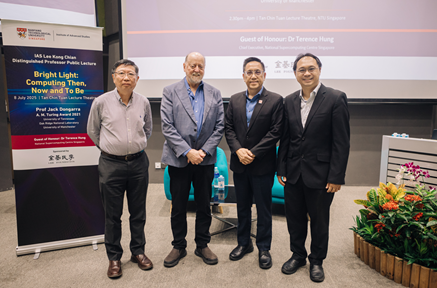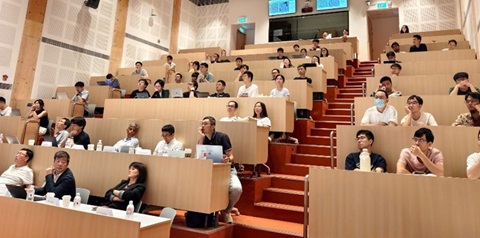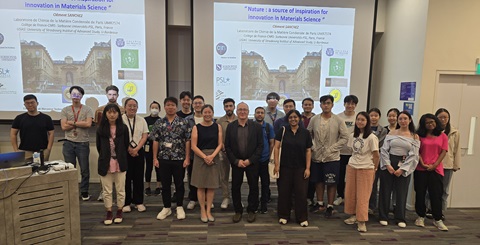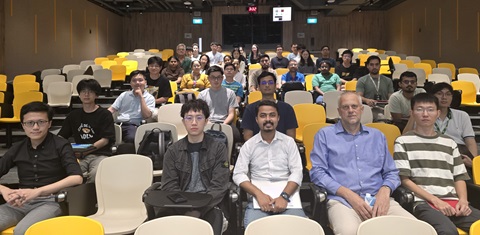AI Tools for Material Enhancement and Discovery in Energy Applications by Prof Eliodoro Chiavazzo
IAS@NTU STEM Graduate Colloquium
Prof Chiavazzo leads the Multi-Scale Modeling Laboratory (SMaLL), where his team combines advanced tools such as atomistic and continuum-scale simulations with machine learning to design next-generation materials for thermal energy storage, solar fuel production, and broader energy applications. His research puts a strong emphasis on data-driven discovery and optimization to develop novel energy conversion and storage solutions.
The talk began by highlighting the importance of low-temperature thermal energy storage (TES) from intermittent sources such as solar and geothermal energy. This can partially fulfil the energy requirements for heating or cooling of buildings which accounts for 40% of global energy consumption and 36% CO2 emission. Prof Chiavazzo focused on his innovative work on application of machine learning tools in two fields: physisorption-based TES systems and solar fuel generation. He explained the promising potential of employing metal-organic frameworks (MOFs) for physisorption-based TES systems by virtue of their high surface area, reversible and tuneable sorption characteristics. He further explained the characteristic S-shape of MOFs-water adsorption isotherms and the limitation to access the MOFs sorption properties for the entire range of isotherm. To address this issue, Prof Chiavazzo highlighted his team’s efforts to reconstruct the adsorption isotherms of MOFs using thermodynamically-consistent Frumkin–Fowler–Guggenheim model. He further explained the objective function as the product of isosteric heat and coverage span (largest difference between the charging and discharging isotherm).

Prof Chiavazzo elucidating the adsorption isotherms of MOFs.
However, the enormous combinatorial space of potential MOFs (estimated at ~10¹⁴ variants) poses a serious bottleneck to experimental screening for identifying MOFs with ideal sorption characteristics. To identify the key MOF crystallographic features underlying the sorption phenomena, his team applies “Sequential Learning”, which is a machine learning strategy that adaptively selects the most informative experiments based on prior data. Prof Chiavazzo demonstrated how this approach accelerates the identification of optimal materials with minimal resource expenditure.
The second half of the talk shifted focus to solar fuel generation, specifically CO₂ reduction to CO using micellar solutions. Here too, machine learning played a pivotal role. Prof Chiavazzo illustrated how AI models can optimise complex chemical reaction parameters, such as catalyst type, buffer concentration, photosensitizer dose, and many others. He took the opportunity to explain the important concept of “Feature Grouping” wherein a group of primitive variables collectively affects the objective function. Identification of feature groups allows enhancement of objective functions by changing the variables which are easier or feasible to modulate while keeping the other factors constant. The team employed “PDF Overlapping Minimization” of the physical data to identify feature groups.
But what happens when the data itself is biased? This sparked one of the most thought-provoking parts of the lecture which addressed the reliability of machine learning predictions in materials science. Prof Chiavazzo highlighted the problem of cross-domain bias—the tendency of models trained on expert-curated datasets to underperform on broader, less-biased materials spaces. He demonstrated how domain expertise can unintentionally narrow the exploration space of machine learning models. Using binary classification techniques, his team quantified and addressed this bias and extended the strategy to energy-relevant materials via the Energy GNoME platform, a bias-corrected generative AI initiative.
The talk concluded with forward-looking perspectives on integrating generative AI, massive text mining using machine learning techniques, high-throughput robotics, and reactive simulations to establish a comprehensive pipeline for the discovery and validation of novel energy materials.
 Prof Chiavazzo addressing questions from the audience during the insightful Q&A session.
Prof Chiavazzo addressing questions from the audience during the insightful Q&A session.
A vibrant Q&A session followed, with students probing the interplay between data-driven insights and domain expertise in materials science. The discussions delved into experimental validation, cost-performance trade-offs, and the practical integration of AI in laboratory workflows. It also highlighted the current limitations of machine learning techniques and machine-learned potentials for reactive simulations.
Prof Chiavazzo’s colloquium underscored the transformative potential of AI in accelerating energy materials research. His work exemplifies how multidisciplinary approaches and the blending of various fields in physics, chemistry, computer science, and engineering are crucial to tackling the world’s energy challenges.

Written by Deshmukh Angad Shrinivas |IGP-ERI@N PhD student.
"The general concepts presented in the colloquium were reasonably understood and conveyed well. Quite a few exciting resources were shared too." - Choong Li Yan Anthony (PhD student, MSE)
" I especially enjoyed learning about the Physics behind thermal battery and how AI is implemented" - Jesaya Christian Ido Raja (PhD student, MSE)
"Clear explanation of different cases." - Fang Ziyu (PhD student, MAE)







